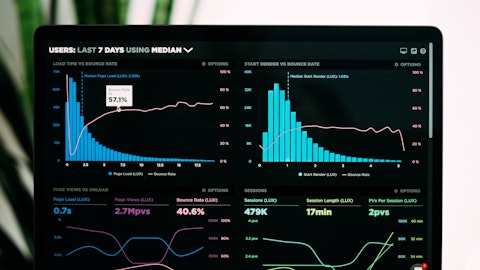Derrick Wood: Great. Thanks for that color. Maybe one for Kevin on the – coming out of last quarter, I think you talked about 500 bips of margin expansion in fiscal ‘24, but that was off of a lower number. You’ve raised your operating margin target this year. You’ve talked about some savings happening earlier than planned. So how should we think about that target for next year? Is that based off kind of the original point of margins last quarter or would you expect to be seeing 500 bips of expansion off of whatever you close in fiscal ‘23?
Kevin Rubin: Yeah, thanks, Derek. I appreciate the question. And yeah, you recall correctly, my commentary on the last call was that we would expect to see about five points plus from the guide at the time, which was an 8% op-margin. So I haven’t updated that particular metric. We’ll do so on the next earnings call. So for now, I would continue to signal that 13% implied leverage point going into ‘24.
Derrick Wood: Okay. Thank you.
Kevin Rubin: Thank you.
Mark Anderson: Thank you Kevin.
Operator: Thank you. Our next question is from Tyler Radke with Citi. Please proceed with your question.
Tyler Radke: Yeah thanks for taking the question. So the gross retention and net retention rate, both overall and I at the G2K held in pretty nicely this quarter. I guess if you think about Q4, where you’re processing a bunch of these single year and multi-year renewals, what’s your confidence level that those can sustain the level that you saw this quarter and any early indications in terms of the linearity of the quarter compared to what you saw in Q4 a year ago? Thank you.
Paula Hansen : Thanks Tyler for the question. So we’re really pleased with the retention rates and expansion rates that we saw in Q3. We obviously took a conservative approach to the guidance and I’m happy to see that we exceeded on those, and I believe that we’ll continue to see that here as we go into Q4. As Mark mentioned, these are full year campaigns that our account teams build an enterprise strategy around in preparation for this large renewal base in Q4. And we expect to continue to see very similar reactions from our customers and positive endorsements around the portfolio, the contract duration and the future that they see with Alteryx.
Mark Anderson : Yeah, and I’ll add to that, if you don’t mind, Tyler, Paula, Suresh, myself, we spent a lot of time with the customers and we continue to hear that they really need our tech to modernize and automate their business, as they digitize and really try to prepare for the world around us that we live in. And so I think it’s just these retention rates just show kind of continued need for what we do for our customers, and that’s really what gives us confidence as well into Q4 and beyond.
Tyler Radke: Great. And a follow-up question is, Kevin, I think you mentioned that you saw a better rep productivity this quarter, which I think is defined as the number of reps against the new bookings. New bookings were still down, I think, year-over-year. I guess, does that imply that the number of reps are down year-over-year? And I guess how far through that kind of performance management are you, and kind of what’s your outlook in terms of quota carrying capacity growth from here? Thank you.
Kevin Rubin : Yeah, thanks, Tyler. So as we talked last quarter, part of the cost initiatives that we’ve executed on this year includes go-to-market resources. And so there are less quota carrier reps today than there were in the prior year period. We also, as Paula articulated, made a number of execution-related changes that we think contributed to the productivity improvements. So we’re really pleased with how that came out in Q3 and you saw that.
Tyler Radke: Thank you.
Mark Anderson : Thanks, Tyler.
Operator: Thank you. Our next question is from Mike Cikos with Needham & Company. Please proceed with your question.
Mike Cikos : Hey, guys. Thanks for taking the questions here. Just a couple on my side. And the first, if I could just ask on the guided ARR we have – and really, I’ve received a couple inbound, so it would be great to just get this out there for everyone. Looking at the Q3 guide versus what we have today, you guys outperformed that midpoint by $11 million, and you’re taking up the full year by $11 million. So essentially, that new ARR in Q4 is unchanged. It would be great to hear – I know that you guys are assuming relatively consistent, which is prudent with the macro, but why not assume some portion of that improved sales execution is the first point? And then the second point, which I’d really like you guys to hone in on, is was there any deal capture for those deals that were pushed out in Q2?
Because again, just trying to get a sense of this outperformance that we saw in Q3. I know we’re attributing it to the enablement, the pipe conversion, but how much of that was deals that may have gotten pushed from Q2 into Q3?
Mark Anderson : Yeah. Hey, Mike. Mark here. I’ll take a crack at that. Listen, they are not giving out any badges for being aggressive on guidance these days. And I think to your point, we’re trying to be prudent and responsible and put a number out there that we feel confident that we can deliver on. And all things considered, we expect gross retention, net retention rates to continue to be world class because I think this team is doing a really good job, especially in this market. In terms of the Q2 deals, we identified more than 10 deals, in and around 10 deals that were not attached to a renewal. I’d say about half of those came in Q3, not necessarily massive deals. Some came in a little higher, some came in a little lower, and the remaining deals are deals that we’re still working on. I’ll tell you, none of these deals were impacted by any competition, anything like that, just mostly by customers’ appetite for spending priorities in quarter.
Mike Cikos : Got it. Got it. Thank you for that. And if I could just – I know you guys are highlighting the more than doubling of the ELA sold this quarter, at least year-on-year. Just wanted to make sure I’m thinking about that properly, but the composition of that more than doubling, is all that or what’s the breakdown between selling of those ELAs between existing customers versus new customers who are coming to Alteryx and just immediately going for the ELA?
Paula Hansen : Sure, Mike, I’ll take that. The ELA is very attractive for existing customers in particular, because you can imagine the journey that those customers are on with us as they add on more departments, more teams, and they show interest in the full functionality of the platform. So, a lot of it is with existing customers. It’s not impossible to land a new customer with an enterprise license agreement, but probably not the first thing that we would try to do with a net new logo.
Mike Cikos : Got it. Makes sense. Thank you very much, Paula.




